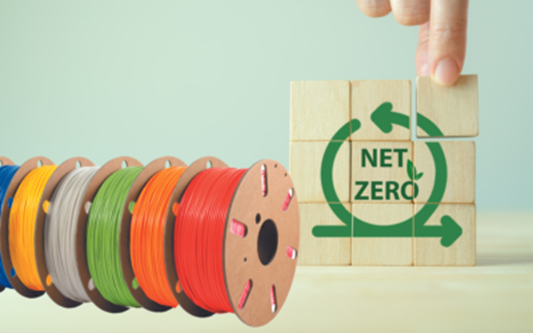The Impact of 3D Printing on Reducing Traditional Manufacturing Waste

Traditional manufacturing processes, such as injection molding, CNC machining, and casting, have been the backbone of production for decades. However, these processes are often wasteful, generating substantial material waste and energy consumption. In an era where sustainability is at the forefront of industrial development, 3D printing (also known as additive manufacturing) is revolutionizing the way products are made and is playing a crucial role in reducing manufacturing waste. Here's how 3D printing is changing the game in waste reduction.
1. Additive Process: Building Objects Layer by Layer
One of the core advantages of 3D printing is its additive nature. Unlike traditional subtractive manufacturing methods, which involve cutting, drilling, or shaving away material from a larger block, 3D printing adds material only where it’s needed. This method builds up objects layer by layer, reducing excess material waste and ensuring that every part of the material contributes to the final product.

In subtractive manufacturing, a significant portion of the material is removed, leaving behind scrap that often ends up in landfills or requires additional processing for recycling. With 3D printing, virtually no waste material is generated, as the printer only uses the exact amount of material needed to construct the object. This dramatically reduces the environmental footprint of manufacturing.
2. Optimized Material Usage
Another advantage of 3D printing is the ability to optimize material usage by creating complex geometries that would be difficult or impossible to achieve with traditional methods. The precision of 3D printing allows manufacturers to design parts with intricate internal structures that use minimal material while maintaining strength and functionality. This is particularly useful in industries like aerospace, automotive, and medical devices, where lightweight, durable parts are essential.

For example, lattice structures, which are often used in 3D printing, are highly efficient at using less material while retaining strength. These structures are perfect for applications like lightweight components in aircraft or car parts. This efficient use of material reduces waste and lowers production costs, offering an economic and environmental benefit to manufacturers.
3. Recyclable Materials and Closed-Loop Systems
The use of recyclable materials in 3D printing is another key factor in reducing waste. Filaments made from recycled plastics, such as recycled PLA or recycled PET, are available for use in 3D printers. This means that manufacturers can reuse post-consumer waste to produce new products, further reducing the amount of material sent to landfills.

In addition, some 3D printing technologies allow for the creation of closed-loop systems, where the waste material from one print job can be reused for the next one. Some companies even implement their own recycling processes to turn failed prints, leftover filament, and other material waste back into usable filament. This closed-loop recycling system helps to minimize overall waste and promote circular manufacturing practices.
 4. Reduction in Production Scrap
4. Reduction in Production Scrap
In traditional manufacturing, especially in processes like CNC machining, a large amount of material is often wasted in the form of production scrap. This scrap is not only material waste but also additional costs associated with handling, storing, and disposing of the waste.
 With 3D printing, production scrap is minimized, as the material is deposited only where it's needed. This is particularly valuable in industries like jewelry, dental, and consumer goods manufacturing, where high levels of precision are required. Additionally, 3D printing enables companies to print smaller batches or even individual products on demand, eliminating the need for large-scale inventories and the associated waste from unsold goods.
With 3D printing, production scrap is minimized, as the material is deposited only where it's needed. This is particularly valuable in industries like jewelry, dental, and consumer goods manufacturing, where high levels of precision are required. Additionally, 3D printing enables companies to print smaller batches or even individual products on demand, eliminating the need for large-scale inventories and the associated waste from unsold goods.
 5. On-Demand Manufacturing
5. On-Demand Manufacturing
Another powerful feature of 3D printing is its ability to enable on-demand manufacturing. Traditional manufacturing processes often rely on mass production, which leads to surplus inventory and waste, particularly when demand is lower than expected. With 3D printing, manufacturers can produce only what is needed, when it’s needed.
This on-demand production model not only eliminates overproduction but also significantly reduces the need for storage, transportation, and packaging. Since 3D printing allows for small-batch or even single-unit production, companies can respond quickly to changing customer demands without creating excess stock that may end up being discarded or sold at a loss.
6. Localized Production and Supply Chain Efficiency
By decentralizing production, 3D printing enables localized manufacturing, reducing the need for long and complex supply chains that contribute to waste and inefficiencies. Traditionally, manufacturing has relied on a global supply chain, with raw materials shipped from different parts of the world to factories for production, then finished goods sent to retailers and customers.
 3D printing allows for localized production near the point of need, reducing transportation waste and associated emissions. Localized production also eliminates the need for large warehouses, reducing the excess inventory that often leads to waste in the form of unsold goods or expired materials.
3D printing allows for localized production near the point of need, reducing transportation waste and associated emissions. Localized production also eliminates the need for large warehouses, reducing the excess inventory that often leads to waste in the form of unsold goods or expired materials.
7. Prototyping Without Waste
In traditional manufacturing, creating prototypes can be a costly and wasteful process. Multiple iterations of a product may require the creation of several prototypes, often resulting in significant amounts of material waste. With 3D printing, rapid prototyping becomes more sustainable, as designers can quickly produce and test prototypes without generating unnecessary waste.

Since 3D printing allows for the creation of prototypes on-demand with minimal material usage, it not only speeds up the design process but also cuts down on waste associated with testing and refining products. This is particularly advantageous in industries like automotive, aerospace, and consumer electronics, where iterative design is a common practice.
8. Sustainability in the Consumer Goods Sector
The consumer goods sector is increasingly adopting 3D printing to reduce manufacturing waste. For example, 3D-printed accessories, home goods, and consumer electronics can be made using less material, and the ability to produce on-demand eliminates the need for mass production and inventory. This helps to reduce the environmental impact of excess products that often end up in landfills.

Moreover, companies are exploring 3D printing to create customizable products, reducing the need for mass-produced, one-size-fits-all items. With 3D printing, consumers can have products designed specifically for their needs, further reducing waste associated with returns and unsold products.
Conclusion
3D printing is significantly contributing to the reduction of waste in traditional manufacturing processes. By minimizing material waste, enabling on-demand production, and promoting recyclable materials, 3D printing is helping industries across the board reduce their environmental footprint. As this technology continues to evolve, it will likely play an even larger role in sustainable manufacturing, offering a viable solution to the waste issues that have long plagued traditional production methods.

With 3D printing, manufacturers can move towards a more sustainable, circular model that benefits both the environment and their bottom line. The future of manufacturing is not only efficient but also greener, and 3D printing is leading the way.









